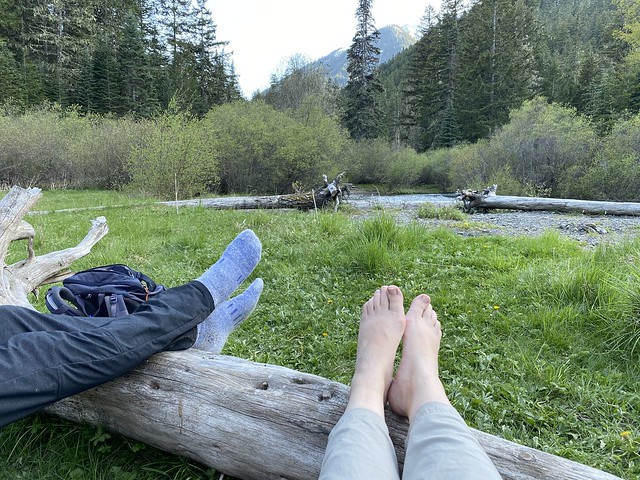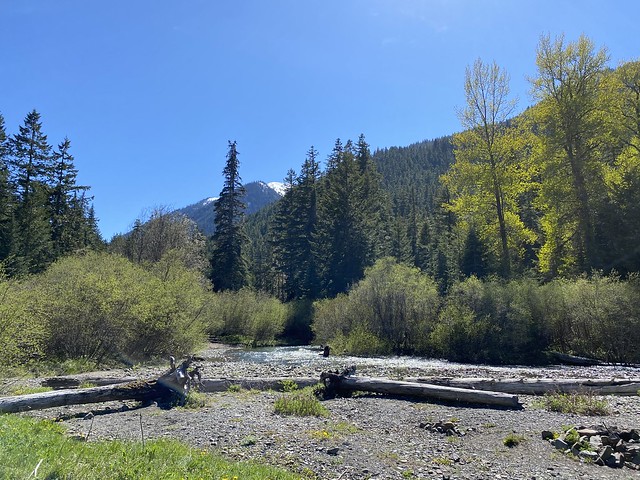Life Pro Tip: If you plan on doing anything outdoors during the summer in the Pacific Northwest, be sure to book your AirBnb, Hotel, camping permit, or anything else requiring reservations, FAR FAR in advance, especially on the Olympic Peninsula.
Even though we remembered to take vacation time for an extended Memorial Day, Phil and I completely forgot to make any reservations. Initially, we had thought to take our motorcycles camping on Whidby Island (which is still on the list). Next, we thought about backpacking the Olympic National Park South Coast. Nope. Finally, we found we could get into the Olympic National FOREST without too much of a headache.
Permits and Reservations in the Olympics
During normal times, the National Parks do take walk up, first come/first serve campers and hikers. Unfortunately, that is not the case in during the COVID-19 pandemic. As such, all the permits are gone months in advance. If you want to book a reservation, you’ll need to go to www.Recreation.Gov to make a reservation. While we were eating lunch after our trip, we went online and booked our reservations for the Olympic National Park. The first available weekend was in mid August.
To park in the Olympic National Forest, you do need a recreation permit. You can purchase them online and print them, or buy them at ranger stations and various other vendors.
Backpacking on the Olympic Peninsula
We got super lucky with the weather – highs in the 70s during the day and lows in the 40s at night. However, the Olympic Peninsula is one of the dampest places in the contiguous United States. You can bet that if you are camping or backpacking on the Peninsula, you will need gear to keep you dry and warm. Pack rain jackets, make sure your tent is waterproof, bring extra layers, and a source of warmth.
In addition, most camps and trails require you to store your food in a bear-proof manner. The easiest way, though bulkiest, is using a bear-proof container. We ended up renting a Bear Vault from REI for just $7 for two nights. The model we rented, the BV500, retails for about $65-85, depending on where you buy it. This takes up a considerable amout of space in your pack, though. Other options include tying up your food 12′ above the ground on a tree limb at least 10′ away from the trunk. Try to make sure you store your food about 200′ (or 70 paces) away from your tent.
Another tip includes forming a triangle with your camp – cook 200′ away from your tent, and store your food around 200′ away from your tent and where you cook, to keep bears and other wild animals away.
Beyond the rain and general damp, you may also encounter run offs, streams, creeks, and rivers along your hikes. While you may count on bridges for large crossings, even small run offs can mean wet feet. Make sure your hiking boots are waterproof, wear wool boot socks, or bring water shoes for crossings. Hiking with wet feet can be very uncomfortable.
Making the Most at Camp
The summer nights on the Olympic Peninsula are insanely long, especially if you come from anywhere south of Washington State. The sun may not set until nine o’clock at night, depending on how near to the summer solstice you are, and how low in a valley you may be.
After a long day of hiking, bring something to pass the time at camp. Cooking a dinner at a camp stove may only take 20-30 minutes, and if you scarf your food after a long day, you may find yourself without much to do at bedtime. Consider bringing a way to read (like an e-reader or a lightweight book), a whittling knife, card games, or another luxury item worth the weight in your pack.
We brought camp chairs, which were definitely worth their weight to us, and an airline bottle of booze each. However, we lamented not having a beer or two each, and at least a deck of cards to pass the time between dinner and bed.
Maps and Navigation in the Olympics
No matter how much tech you think you have, or how far tech advances, you might be surprised how little it matters in the wilderness. We lost signal around the Dungeness Forks Campground, heading towards the Dungeness Trail, and at Lake Cushman, when heading to Staircase Rapids. Do NOT count on your cell phone for navigation unless you have downloaded a map as an image to your phone’s internal memory.
Using a GPS signal device may be worth the price if you are worried about getting lost. These devices allow you to set a “home” location that notifies your family when you start a hike via text or email, then tells them once you have returned from your hike. These devices work even if you don’t have cell phone coverage, but need clear sky to work. If you are hiking in a canyon, they may lose signal.
Nothing beats having and knowing how to read a physical map that has enough detail to cover your hike. We had a waterproof map of the Olympic National Park, but only realized after we set out that our camp was not marked on the map. We had to rely on our memory to remember where it was on the topographic map, alongside a photo on a phone. This map in particular actually had Camp Handy on it on the Upper Dungeness Trail, whereas this map did not.
If you want to see more about our adventures, check out our Youtube Channel A&A Backyard on Youtube.



One thought on “Backpacking and Hiking on the Olympic Peninsula”